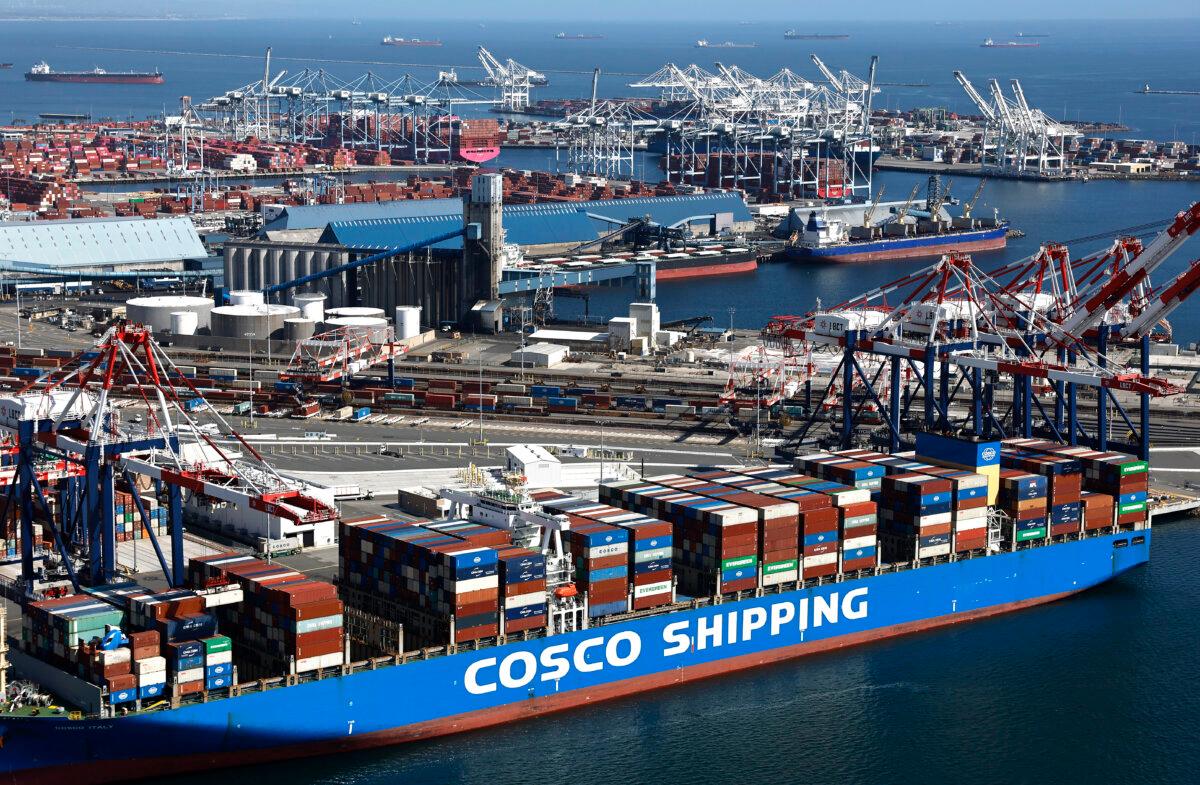Despite joining the WTO in 2001, China did not evolve into the fully-fledged market economy that the United States had hoped for.
WASHINGTON—As part of a major shift in U.S. trade policy, President Donald Trump has ramped up tariffs on Chinese goods, which he said will revive domestic manufacturing and correct decades of imbalanced trade between the two economies.
At the April 2 “Make America Wealthy Again” event in the White House Rose Garden, Trump unveiled the contours of his global tariff plans, including a 34 percent reciprocal levy on Beijing. The president noted China’s currency manipulation and other non-monetary trade barriers.
This decision raised the total new tariffs on China to 54 percent, including the 20 percent levies previously imposed to pressure Beijing into reducing the flow of fentanyl into the United States.
This move will impact the approximately $600 billion in annual trade and bring tariffs on nearly all Chinese goods close to the 60 percent rate Trump had previously promised during his campaign.
Trump said that the United States holds leverage over other nations, including China, due to its status as the world’s largest and wealthiest consumer market.
“Foreign nations will finally be asked to pay for the privilege of access to our market, the biggest market in the world,” Trump said during his Rose Garden speech.
China quickly hit back, announcing that, starting April 10, it would impose 34 percent tariffs on imports of all U.S. goods. This move was part of a broader set of retaliatory actions, including tightening export controls on various rare earth elements and adding U.S. companies to the government’s “unreliable entities list.”
Beijing also filed a complaint with the World Trade Organization (WTO), following through on a threat earlier this week.
In response, Trump said the Chinese regime “played it wrong.”
“They panicked—the one thing they cannot afford to do,” the president said in a post on social media platform Truth Social.
Some Republican lawmakers have expressed concerns about the economic impact of the new tariffs, and they remain hopeful that Trump’s approach will ultimately address issues with China and encourage other trading partners to reduce their trade barriers.
Sen. Ted Cruz (R-Texas) told The Epoch Times that he had urged the president to concentrate on China and reciprocity in global trade.
“I think every effort we can take to delink our economy from China is beneficial, both to U.S. national security and to our economic security,” he said.
By installing reciprocal tariffs on other countries, Cruz hopes that U.S. trading partners will “dramatically reduce the tariffs they put on American goods.” While it might take time to determine how other countries respond, any potential decrease in tariff rates “would be a terrific result.”
“If the result is tariffs going up worldwide, that would be a terrible result,” he added.

A Cosco Shipping container ship, China’s largest shipping line, loaded with shipping containers in the Port of Long Beach, Calif., on April 3, 2025. Tama/Getty Images
Sen. Mark Kelly (D-Ariz.) said that China tariffs should be more targeted. He said imposing 54 percent tariffs on all Chinese goods is not a sensible approach.
“I think targeted tariffs on specific industries to accomplish specific goals make sense,” he told The Epoch Times.
He added that Trump’s tariff policy is “an assault on the American taxpayer and consumer and American families like we haven’t seen since the 1930s.”
Trade Distorting Practices
Despite joining the WTO in 2001, China did not evolve into the fully-fledged market economy that the United States had anticipated.
China’s economic growth has accelerated dramatically since the country joined the WTO. However, the Chinese Communist Party’s trade-distorting practices, such as intellectual property theft, massive state subsidies, currency manipulation, wage suppression, and labor rights violations, have led to the closure of many U.S. manufacturers and the loss of millions of U.S. jobs.
There is a bipartisan view in Washington on the need to address China’s market practices.
Before the November election last year, President Joe Biden’s National Security Advisor Jake Sullivan defended tariffs against China.
“Previous efforts to build a China policy on changing China have not succeeded,” Sullivan said on Oct. 24.
As a result, he said, the United States must adopt a new set of strategies based on the current geopolitical and economic realities.
During his first term, Trump imposed tariffs on more than $300 billion worth of Chinese goods in response to various unfair trade practices, including intellectual property theft.
The Biden administration chose to maintain those tariffs and announced additional tariffs on products such as electric vehicles (EVs), solar panels, medical equipment, lithium-ion batteries, steel, and aluminum.
Both administrations have used tariffs to level the playing field for domestic manufacturers and American workers.
Nick Iacovella, executive vice president for the Coalition for a Prosperous America, an organization that represents domestic producers and workers, said that Trump’s new tariffs will address the decades of deindustrialization in the United States.
“It is incredibly important that those tariffs actually stay in place,” he told The Epoch Times.
For decades, there has been a disconnect between Wall Street and Main Street, Iacovella said, commenting on the recent market reaction to the global tariffs.
“When automakers moved their jobs to Mexico, their stock prices went up, but car prices didn’t decrease for American consumers,” he said.

Traders work on the floor of the New York Stock Exchange during morning trading on April 3, 2025 in New York City. Michael M. Santiago/Getty Images
Regarding Beijing’s retaliatory actions, Adam Savit, China policy director at America First Policy Institute, said China has less leverage.
“The U.S. has much less exports to China than China exports to the United States. So inherently, they’re at a disadvantage,” he told The Epoch Times.
He stated that charging 54 percent tariffs on Chinese goods is an appropriate response to an adversary, and it will help in the strategic decoupling from China.
De Minimis Exemption
The de minimis trade exception—cheap imports that enter the United States duty-free—will be coming to an end next month.
Alongside sweeping tariffs, Trump signed an executive order closing the trade loophole for low-value goods from China, beginning May 2.
The White House called this “a critical step in countering the ongoing health emergency posed by the illicit flow of synthetic opioids into the U.S.” China is the main exporter of precursor for fentanyl, which is at the center of the United States’s opioid crisis.
The president had initially ended the exemption in February but quickly pivoted after the executive order overwhelmed U.S. Customs and Border Protection (CBP) employees and forced the U.S. Postal Service to suspend processing packages from China and Hong Kong.
According to a White House fact sheet, the CBP processes more than four million de minimis shipments into the United States daily.
Bargaining Chip
On April 4, Trump extended the deadline for TikTok to divest from its Beijing-based parent company by 75 days.
The president made the announcement in a post on Truth Social, just ahead of the original April 5 deadline.
“My Administration has been working very hard on a Deal to SAVE TIKTOK, and we have made tremendous progress,” Trump wrote. “The Deal requires more work to ensure all necessary approvals are signed, which is why I am signing an Executive Order to keep TikTok up and running for an additional 75 days.”
Trump stated that he would continue working in “good faith” with China. Previously, he suggested that tariffs could be used as a bargaining chip to pressure China into approving the sale of TikTok’s U.S. operations from ByteDance, which several U.S. officials have warned has ties to the Chinese Communist Party.
“You have a situation with TikTok where China will probably say: ‘We’ll approve a deal, but will you do something on the tariffs?’” Trump said on April 3. “We could use tariffs in order to get something in return.”

TikTok app logo is seen in this illustration taken on Aug. 22, 2022. Dado Ruvic/Illustration/Reuters
Concessions
While China chose to retaliate, some trading partners have already begun signaling concessions.
Trump confirmed on Truth Social on April 4 that he had a “very productive call” with To Lam, the general secretary of Vietnam’s Communist Party.
The Southeast Asian country, which has greatly benefited from global supply chain adjustments since the coronavirus pandemic, is ready to negotiate, Trump said.
Trump earlier announced implementing a reciprocal tariff rate of 46 percent on Vietnam. Last year, the U.S. trade deficit with Vietnam was more than $113 billion, the third largest behind China ($270.4 billion) and Mexico ($157.2 billion).
“Vietnam wants to cut their tariffs down to zero if they are able to make an agreement with the U.S.,” Trump said. “I thanked him on behalf of our country, and said I look forward to a meeting in the near future.”
While Vietnamese officials have indicated they are ready to negotiate lower tariffs on both sides, the U.S. Trade Representative’s comprehensive report identified various non-monetary trade barriers.
The 2025 National Trade Estimate Report, a prelude to Trump’s “Liberation Day” announcement, listed the country’s various import bans and restrictions, extensive product registration requirements for imported pharmaceuticals, and various technical barriers to trade.
Terri Wu, Jacob Burg, and Nathan Worcester contributed to this report.
Original News Source Link – Epoch Times
Running For Office? Conservative Campaign Consulting – Election Day Strategies!


